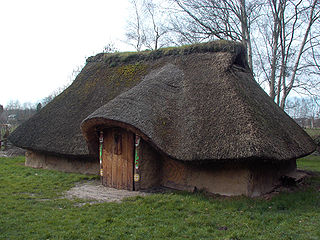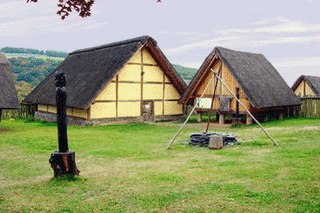Related Research Articles

The Nervii were one of the most powerful Belgic tribes of northern Gaul at the time of its conquest by Rome. Their territory corresponds to the central part of modern Belgium, including Brussels, and stretched southwards into French Hainault. During their first century BC Roman military campaign, Julius Caesar's contacts among the Remi stated that the Nervii were the most warlike of the Belgae. In times of war, they were known to trek long distances to take part in battles. Being one of the northerly Belgic tribes, with the Menapii to the west, and the Eburones to their east, they were considered by Caesar to be relatively uncorrupted by civilization. According to Tacitus they claimed Germanic descent. According to Strabo they were of Germanic origin.

The Menapii were a Belgic tribe dwelling near the North Sea, around present-day Cassel, during the Iron Age and the Roman period.

The Lingones were a Gallic tribe of the Iron Age and Roman periods. They dwelled in the region surrounding the present-day city of Langres, between the provinces of Gallia Lugdunensis and Gallia Belgica.

The Tungri were a tribe, or group of tribes, who lived in the Belgic part of Gaul, during the times of the Roman Empire. Within the Roman Empire, their territory was called the Civitas Tungrorum. They were described by Tacitus as being the same people who were first called "Germani" (Germanic), meaning that all other tribes who were later referred to this way, including those in Germania east of the river Rhine, were named after them. More specifically, Tacitus was thereby equating the Tungri with the "Germani Cisrhenani" described generations earlier by Julius Caesar. Their name is the source of several place names in Belgium, Germany and the Netherlands, including Tongeren, Tongerlo Abbey, and Tongelre.

The Remi were a Belgic tribe dwelling in the Aisne, Vesle and Suippe river valleys during the Iron Age and the Roman period. Their territory roughly corresponded the modern Marne and Ardennes and parts of the Aisne and Meuse departments.

The Trēverī were a Germanic and/or Celtic tribe of the Belgae group who inhabited the lower valley of the Moselle in modern day Germany from around 150 BCE, if not earlier, until their displacement by the Franks. Their domain lay within the southern fringes of the Silva Arduenna, a part of the vast Silva Carbonaria, in what are now Luxembourg, southeastern Belgium and western Germany; its centre was the city of Trier, to which the Treveri give their name. Celtic in language, according to Tacitus they claimed Germanic descent. They contained both Gallic and Germanic influences.

The Eburones were a Gallic-Germanic tribe dwelling in the northeast of Gaul, in what is now the southern Netherlands, eastern Belgium and the German Rhineland, in the period immediately preceding the Roman conquest of the region. Though living in Gaul, they were also described as being both Belgae and Germani.

The Suessiones were a Belgic tribe, dwelling in the modern Aisne and Oise regions during the La Tène and Roman periods.

The Morini were a Belgic coastal tribe dwelling in the modern Pas de Calais region, around present-day Boulogne-sur-Mer, during the Iron Age and the Roman period.

The Condrusi were an ancient Belgic-Germanic tribe dwelling in what is now eastern Belgium during the Gallic Wars and the Roman period. Their ethnic identity remains uncertain. Caesar described them as part of the Germani Cisrhenani, but their tribal name is probably of Celtic origin. Like other Germani Cisrhenani tribes, it is possible that their old Germanic endonym came to be abandoned after a tribal reorganization, that they received their names from their Celtic neighbours, or else that they were fully or partially assimilated into Celtic culture at the time of the Roman invasion of the region in 57 BC.
The Frisiavones were a Germanic people living near the northern border of Gallia Belgica during the early first millennium AD. Little is known about them, but they appear to have resided in the area of what is today the southern Netherlands, possibly in two distinct regions, one in the islands of the river deltas of Holland, and one to the southeast of it.

The Mediomatrici were according to Caesar a Gaulish tribe at the frontier to the Belgicae dwelling in the present-day regions Lorraine, Upper Moselle during the Iron Age and the Roman period.
The Caletes or Caleti were a Belgic or Gallic tribe dwelling in Pays de Caux, in present-day Normandy, during the Iron Age and the Roman period.

The Ambiani were a Belgic coastal tribe dwelling in the modern Picardy region during the Iron Age and Roman periods.
The Paemani were a small Belgic-Germanic tribe dwelling in Gallia Belgica during the Iron Age. Their ethnic identity remains uncertain. Caesar described them as part of the Germani Cisrhenani, but a number of scholars have argued that their name may be of Celtic origin. Like other Germani Cisrhenani tribes, it is possible that their old Germanic endonym came to be abandoned after a tribal reorganization, that they received their names from their Celtic neighbours, or else that they were fully or partially assimilated to Celtic culture at the time of the Roman invasion of the region in 57 BC.
The Veliocasses or Velocasses were a Belgic or Gallic tribe of the La Tène and Roman periods, dwelling in the south of modern Seine-Maritime and in the north of Eure.
The Caerosi were a small Belgic-Germanic tribe dwelling in Gallia Belgica during the Iron Age and the Roman period. Their ethnic identity remains uncertain. Caesar described them as part of the Germani Cisrhenani, but their tribal name is probably of Celtic origin. Like other Germani Cisrhenani tribes, it is possible that their old Germanic endonym came to be abandoned after a tribal reorganization, that they received their names from their Celtic neighbours, or else that they were fully or partially assimilated into Celtic culture at the time of the Roman invasion of the region in 57 BC.
The Catalauni were a Belgic tribe dwelling in the modern Champagne region during the Roman period. The Catalauni probably belonged to a larger tribe, either the Remi in the north or the Lingones in the south. The Catuvellauni, who migrated to southern Britain in the 1st century BC, are likely part of the same tribal group.
The Silvanectes were a small Belgic tribe dwelling around present-day Senlis (Oise) during the Roman period.
The Catuslugi were a small Belgic coastal tribe dwelling around modern-day Incheville (Normandy) during the Roman period.
References
- ↑ Wightman 1985, p. 54.
- ↑ Spickermann 2019, p. 468.
- ↑ Tacitus . Historiae, 4:70.
- ↑ Sergent 1991, pp. 10–11.
- ↑ Neumann 1999, pp. 110–111.
- ↑ Delamarre 2003, p. 97.
Primary sources
- Tacitus (1925). Histories. Loeb Classical Library. Translated by Moore, Clifford H. Harvard University Press. ISBN 978-0674991231.
Bibliography
- Delamarre, Xavier (2003). Dictionnaire de la langue gauloise: Une approche linguistique du vieux-celtique continental. Errance. ISBN 9782877723695.
- Neumann, Günter (1999), "Germani cisrhenani — die Aussage der Namen", in Beck, H.; Geuenich, D.; Steuer, H. (eds.), Germanenprobleme in heutiger Sicht, Walter de Gruyter, ISBN 978-3110164381
- Sergent, Bernard (1991). "Ethnozoonymes indo-européens". Dialogues d'Histoire Ancienne. 17 (2): 9–55. doi:10.3406/dha.1991.1932.
- Spickermann, Wolfgang (2019). "Les Provinces Germaniques, un Champ d'Analyses pour l'Histoire des Religions". In Hurlet, Frédéric (ed.). Rome et l'Occident: Gouverner l'Empire (IIe siècle av. J.-C. - IIe siècle ap. J.-C.). Presses universitaires de Rennes. ISBN 978-2-7535-6690-3.
- Wightman, Edith M. (1985). Gallia Belgica. University of California Press. ISBN 978-0-520-05297-0.
